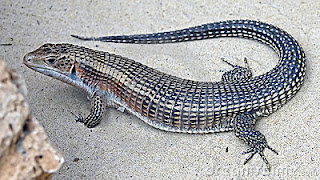 |
| Giant plated lizard. |
The giant plated lizard is large in size, with a flattened
head and body, and can reach a total length of 75 cm (29.5 in). Adults are a dark
brown to black colour with bars, a yellowish tint in colour, running down their backs, a white throat and light brown belly. Youngsters are the same in colour but have a more prominent yellow speckled appearance and stripes running along their
backs, which fade with age.
They have specially adapted black soles on their feet that
are rubber-like balls for living amongst rock outcrops.
Giant plated lizards are found in the north-eastern parts of
Limpopo, Mpumalanga and KwaZulu Natal within South Africa. They are also found
in other countries of southern African such as Angola, Botswana, Malawi,
Mozambique, Namibia, Swaziland, Zimbabwe and Zambia.
They live in the rocky outcrop areas which are mostly
situated on the upper slopes of granite hills.
Behaviour
They are highly territorial reptiles although not solitary
and will live in small family groups.
A shy lizard by nature they are hard to approach and will
usually jam themselves into a rock crevice when feeling threatened by
flattening their body and inflating themselves with air, making it impossible
to pull them out.
With their strong and muscular legs, they are able to move
effortlessly among the rock faces in their territory.
Diet
Giant plated lizards are omnivorous with a varied selection
of flora and fauna to choose from to eat. They feed on flowers, leaves, soft
fruits such as figs and will eat other smaller lizards as well as baby
tortoises.
They move slowly when searching for their food while
scraping through loose soil or leaf litter for possibly hidden snacks.
When breeding season begins in summer, the males develop a
pinkish-red in colour hint to their throat and sides of head. Males become
highly territorial and will fight with one another, while persistently tailing a female.
Females are oviparous meaning they lay eggs after mating. They
seek out soil-filled rock crevices in which to lay and hide their 2 to 5 oval
shaped eggs. Giant plated lizards are 150 to 170 mm long when hatched.
Did you know?
Those that prey on the giant plated lizard are snakes, some
mammals and a selection of birds of prey.



No comments :
Post a Comment